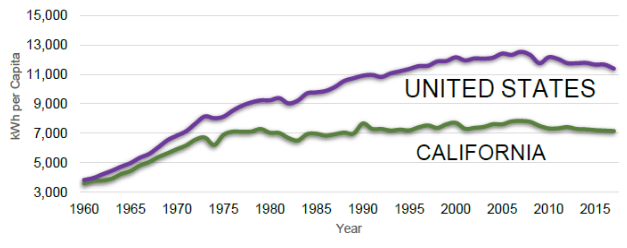Buildings use energy for water heating, space heating, cooling, lighting, and other appliance usage. In 2021, the operation of buildings accounted for about 27% of energy-related carbon dioxide (CO2) emissions globally. And the global energy demand from buildings continues to rise, driven by a growth in (1) buildings floor area, (2) access to energy in developing countries, (3) cooling demand, and (4) ownership of appliances.
As such energy demand is met by fossil fuels (e.g. natural gas, propane, coal) consumed on-site or electricity, building energy efficiency is key to reducing the buildings’ carbon footprint. This post describes how energy use and greenhouse gas (GHG) emissions from buildings can be reduced using California’s example. With its first appliance and building efficiency standards dating back to 1976 and 1978, California has a long history of pursuing energy efficiency in buildings, which helped its per-capita energy consumption remain stable since the 1980s (see Figure 1).
Figure 1. Electricity consumption per capita in US and California

Source: CEC (2019)1
California aims to decarbonize the buildings sector in the following ways: (1) building energy efficiency standards, (2) appliance efficiency standards, (3) incentivizing retrofits of existing buildings, and (4) electrifying energy end uses and cleaning the grid.
The building energy efficiency standards (Title 24), updated every three years by the California Energy Commission (CEC), set rules for new construction of new buildings as well as substantial additions and alterations to existing buildings. While the specifics differ by building types and climate zones, new building efficiency standards encourage or require the adoption of new technologies such as solar photovoltaic (PV) systems, battery storage, and heat pumps. Energy efficiency measures are also cost-effective for building owners over the life of the building.
The appliance efficiency regulations (Title 20) apply to appliances sold in California and set minimum efficiency levels for energy and water consumption, prohibiting the sale of less efficient appliances within the state. While states are preempted from adopting their own standards for the products covered by federal standards, which cover more than 50 products representing about 90% of home energy use and 60% of commercial building energy use, California continues to develop efficiency standards for other products like computers or sprinklers.
Since 50% of its single-family houses and 60% of its apartment complexes were built before the state’s first building standards (“pre-1978”), there is a great potential for energy efficiency gains from these existing buildings. To achieve these gains, the state’s utilities are required to implement energy efficiency programs, which encourage their customers to switch to new and efficient technologies through financial incentives (e.g., energy savings assistance, rebates, loans), behavioral programs, and education and outreach. The CEC also requires the owners of large buildings to publicly disclose their energy use so that anyone can see how efficient or inefficient any building is and make better-informed decisions about purchasing, leasing, maintenance, and upgrades.
Finally, electrification of end uses are not only energy efficient but also can reduce GHG emissions from on-site fossil fuel combustion and methane leakages. As gas appliances emit air pollutants such as carbon monoxide, nitrous oxides, particulate matter, and formaldehyde, electrifying those appliances also improves indoor air quality. Examples include the CEC requiring all new homes to be electric-ready or the city of Berkeley banning natural gas hookups in new buildings. This, of course, will have to be accompanied by clean electricity supply for the building sector to decarbonize.
China accounts for about half of the world’s new building area and the building operation accounts for one-fifth of the country’s carbon emissions. Therefore, it can benefit greatly from building energy efficiency and has indeed focused on energy efficiency to control energy demand and, increasingly, carbon emissions. China connected with California's energy efficiency policies in the 1980s and developed building and appliance efficiency standards, with a lot of technical assistance from the Lawrence Berkeley National Lab's China Energy Program. While China’s initial standards built off of those of California’s, some of California’s recent efficiency standards (for example, for computer monitors) were built upon those of China’s. Continued dialogue and competition between California and China will help develop groundbreaking energy efficiency policies and reduce emissions from buildings.
1. California Energy Commission. (2019, November). 2019 California Energy Efficiency Action Plan, p. 16. California Energy Commission. https://www.energy.ca.gov/filebrowser/download/1900
Photo credit: Creative Commons Images, Indianhilbilly

